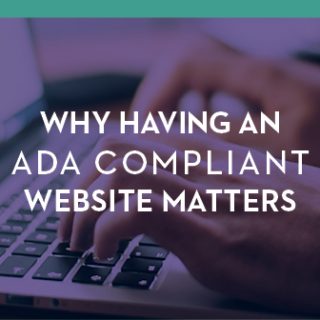At Able&Co., our team of web experts strive toward American Disability Act (ADA) Compliance standards and are renewing our efforts to ensure every website we develop and maintain offers optimal accessibility. In addition to a proactive approach towards compliance, it’s important that we share vital information about these guidelines so that business owners, marketers and consumers alike can understand this important, albeit complex, concept.
What is ADA Compliance?
The original intention of the World Wide Web was to share knowledge with as many people as possible. Yet as the internet evolved and grew, accessibility of websites started to become compromised – whether it was for design, innovative features or another change. Not everyone could consume the content they wanted or needed.
In 2010, Phase III of the ADA implemented guidelines and standards which includes a company’s website as “a place of public accommodation.” By following these regulations, website functionality, design and content can be accessible by anyone. In other words, just as sections of the ADA enforce building codes such as required wheelchair ramps, railings or automatic doors, a website must adhere to rules which work towards the same level of accessibility. This has helped people with disabilities gain access to information everyone already has tremendously.
Why is Compliance Important?
No matter if a visitor to your website has vision challenges, auditory challenges or any other form of disability, they will be able to access content they are looking for if your website abides by these important standards. In addition, noncompliance can also prove to have negative consequences. According to Title III, noncompliant websites could potentially be considered discriminatory against those unable to access content without accommodations. This can lead to fines and a variety of other issues if left unchecked. While many legal authorities do stress that websites and the businesses that own them have flexibility in implementation, it’s vital to be proactive in this very transitory time.
Beyond striving toward compliance for accessibility reasons, these advances also encourage a clear and concise layout, making a pleasant browsing experience for any visitor. It adds simplicity do your website’s copy, design, imagery and navigation.
“By working towards an ADA-compliant website, you’re working towards a simplified website that delivers an overall better browsing experience. Your audience will thank you,” our lead web developer, Joshua Craig said.
How to Move Your Website Toward Compliance
With newly published guidelines under Section 508 of the Rehabilitation Act, Website Accessibility Standards (WAS) and Web Content Accessibility Guidelines (WCAG) 2.0 Level AA, web developers can apply these standards to their websites in clear-cut ways. For instance, WCAG has 34 items on their guideline list that web developers should know. Here are just a few of the most common:
- Videos with audio must have captions as well as a second alternative for content access, such as transcripts or voice description services.
- Audio should not automatically play.
- Content cannot be accessible by keyboard only.
- Content cannot flash more than three times per second.
- All errors must be clearly designated when user incorrectly fills out a form.
- All elements must have labels and instructions.
- Websites must have clearly defined page titles.
- Alternative text for readers that comply with screen readers.
It’s clear to see that each one of these — and the 27 other guidelines from WCAG — can help web developers create content that is easy to access and understand.
An Action Plan
Some developers automatically go to a variety of plugins and while some tools are helpful when working towards compliance, certain plugins have been considered non effective and miss vital points, leaving your website vulnerable. There is no singular solution other than a team of knowledgeable website experts working towards this important goal. Here are some important first steps:
-
- Initiate a complete audit of your website. Web developers with keen knowledge of these guidelines have the ability to thoroughly inspect the accessibility of a website.
- Create a list of all items that are outstanding with your website’s compliance. When you first start, this list will be long, but the right web developer team will achieve success.
- Make a realistic and action-oriented timeline and task list for your web team to work towards.
Information for All
As any web developer will tell you, ADA compliance is a considerable task, but worth every ounce of effort. By sticking to these guidelines, you can transform your website and ensure it is more user-friendly and legally compliant. As always, contact us today to see how our team can help you revolutionize your online presence.


